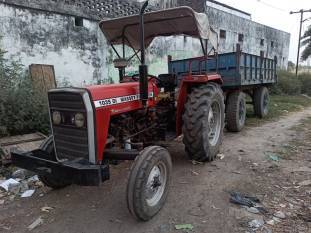MUMBAI, 29 July 2024: India's agricultural sector is the backbone of the nation, employing over half of the workforce and contributing significantly to the GDP. However, this success story wouldn't be possible without the tireless efforts of farmers and the crucial role of modern farm equipment.
From sowing seeds to harvesting crops, these technological marvels are revolutionizing the way agriculture is practiced in India. Let's explore the top 10 farm equipment that are transforming Indian farms:
Tractors: The Workhorse of Indian Agriculture
Undoubtedly the king of farm equipment in India, tractors are the ultimate multitaskers. They can be used for ploughing, tilling, sowing, hauling trailers, and powering various agricultural implements. Modern tractors offer superior horsepower, fuel efficiency, and ergonomic designs, allowing farmers to cover larger areas with less effort. The availability of various attachments further enhances their versatility, making them an indispensable asset for any farm.
Combine Harvesters: Maximizing Grain Harvest
Gone are the days of laborious manual harvesting. Combine harvesters, with their efficient cutting, threshing, and separating mechanisms, have significantly reduced harvest time and manpower requirements. These sophisticated machines can harvest a variety of crops, including wheat, paddy, and corn, minimizing grain loss and ensuring a higher yield. The adoption of combine harvesters is crucial for large-scale farms and contributes to meeting the growing demand for food grains.
Seed Drills: Precision Sowing for Optimal Crop Density
Precision is key to a successful harvest. Seed drills ensure seeds are sown at the right depth, spacing, and density, promoting optimal plant growth and maximizing yield. Gone are the days of uneven sowing by hand. Seed drills come in various configurations, from manual to tractor-mounted, catering to different farm sizes and budgets. Their accuracy helps farmers optimize seed usage and reduce wastage, leading to increased profitability.
Rotavators: The Powerhouse for Tilling and Seedbed Preparation
Rotavator, a rotary tiller, is a game-changer for efficient soil preparation. It pulverizes and levels the soil, creating the perfect seedbed for germination. Rotavator's ability to break up hardpan layers and incorporate organic matter into the soil improves drainage, aeration, and nutrient availability for growing crops. Compared to traditional ploughs, rotavators offer faster operation, reduced fuel consumption, and improved soil health.
Ploughs: A Timeless Tool for Land Preparation
While tractors have taken center stage, the humble plough remains a vital tool for many Indian farmers. Used for breaking up compacted soil, creating furrows, and burying crop residues, ploughs are particularly suitable for smaller farms or those with challenging soil conditions. Modern ploughs come in various designs, such as moldboard ploughs and disc ploughs, offering farmers options to match their specific needs.
Threshers: Separating Grain from the Rest
Threshing, the process of separating grains from the chaff after harvest, is a crucial step in post-harvest processing. Traditional methods like manual threshing are time-consuming and labor-intensive. Threshers, both stationary and mobile, have revolutionized this process. By utilizing a combination of beating and separating mechanisms, threshers efficiently separate grains from straw, saving time and labor costs for farmers.
Sprayers: Protecting Crops from Pests and Diseases
Crops are vulnerable to a variety of pests, diseases, and weeds. Sprayers ensure targeted and efficient application of pesticides, herbicides, and fungicides. Modern sprayers come in various forms, including knapsack sprayers for small farms and tractor-mounted boom sprayers for larger fields. They allow farmers to control crop damage effectively, minimizing yield losses and ensuring food security.
Cultivators: Weeding and Aerating for Healthy Growth
Once crops have emerged, weeds can compete for vital resources like water and nutrients. Cultivators are specifically designed to remove weeds growing between crop rows without damaging the main plants. Additionally, cultivation promotes soil aeration, allowing for better root development and nutrient uptake by crops. Cultivators come in various sizes and configurations, offering farmers flexibility depending on their row spacing and crop type.
Power Tillers: A Versatile Option for Small Farms
For small and medium-sized farms, power tillers serve as a cost-effective alternative to tractors. These compact and maneuverable machines offer a range of functionalities, including tilling, ploughing, and powering various attachments. Power tillers are fuel-efficient and perfect for farms with limited space or challenging terrain. They are also a popular choice for farmers who are transitioning from traditional, manual farming practices to mechanized agriculture.
Irrigation Equipment: A Lifeline in Arid Regions
Water scarcity is a major challenge for Indian agriculture. Irrigation equipment, including sprinklers, drip irrigation systems, and micro-irrigation technologies, provide a lifeline for farmers in arid and semi-arid regions. These systems deliver water directly to the root zone, minimizing evaporation and maximizing water use efficiency.
The Future of Farm Equipment in India
The landscape of farm equipment in India is constantly evolving. Emerging technologies like precision agriculture, automation, and the Internet of Things (IoT) are poised to further revolutionize Indian farms.
Precision agriculture utilizes sensors and data analysis to optimize inputs like water, fertilizers, and pesticides based on real-time field conditions.
Automation through robotic technologies and self-driving tractors promises to reduce manual labor and increase efficiency.
IoT integration allows farmers to remotely monitor and control farm equipment, enhancing decision-making and optimizing resource utilization.
By embracing these advancements, Indian agriculture can become more sustainable, productive, and profitable, ensuring food security for the nation and contributing to global food security efforts.























